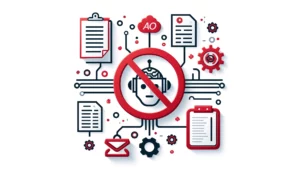AI for CLM & Document Automation
Where does AI bring value and where are its limitations?
The current AI hype is different from all the blockchain hype a few years ago because AI-powered automation actually makes sense, and brings value to the CLM and Document Automation space. However, it is still just hype, which means that we are constantly discussing whether AI can solve absolutely everything. Let’s take a look at where AI will elevate CLM and Document Automation features, and where non-AI automation brings higher value to digital transformation.
AI-powered vs Non-AI Automation
Organizations basically have two ways to approach digital transformation (automation):
![]()
a) Create the logic and rules according to which the final product (e.g., a document) is constructed. No Code / Low Code tools like Legito allow the configuration of this logic by making selections in a user interface instead of programming. The software is not self-learning, but it always returns the correct results.
b) Leave it to artificial intelligence by giving it some data for learning, it builds its own logic and then returns more or less accurate results.
Both approaches may complement each other.
Three Important Questions
AI is not flawless and always works on the basis of probability, I would recommend everyone ask themselves these 3 questions before starting to think about implementing AI to automate certain tasks:
- Can I accept that AI returns different results in two identical situations?
- Can I accept that nobody will be able to tell me exactly why AI returns these particular results?
- Can I accept that if the AI returns incorrect results, there is no quick and easy fix?
If your answer to all 3 of these questions is “yes”, then I recommend you consider using AI to automate such tasks, otherwise automating the tasks by using pre-defined logic (Non-AI) will bring you more value.
Why won’t AI replace CLM but complement it?
![]()
Ultimately, CLM is about accuracy, accountability, and risk mitigation.
Each CLM process contains multiple tasks, and many of them require a wide knowledge context. At the same time, each organization has its own specific process and policies for CLM.
Having AI drive the entire process is risky because the precision is simply not good enough, yet for such a complex process with a focus on accuracy, there is always the potential to cause substantial damage if not done correctly.
Having said that, AI can be a valuable assistant to humans for some of the tasks within CLM processes, helping us to manage these tasks efficiently.
At Legito, we see AI as an extension of the defined logic and rules for CLM. In other words, we believe that the core of CLM will be based on non-AI automation, and it will contain multiple narrow-focused AI tools that will assist humans with individual CLM tasks.
Why won’t AI replace Document Automation but expand it?

The short answer is that there is no acceptable room for error in legal and business documents.
Let’s start with an example of using AI to create marketing content vs a legal document.
A skilled marketer might create better marketing content than AI, but if the AI creates marketing content with 80% or 90% quality compared to a skilled marketer, that’s more than good enough in most cases. It doesn’t matter as much that the quality is not 100% because the efficiency benefits highly outweigh the slightly reduced content quality. There is also no substantial risk of potential damages.
On the other hand, if you allow AI to draft a contract, even if the AI can produce 90% accuracy like a lawyer, it’s still not good enough to use this technology in practice, because even just one missing comma, digit, or wrong word can cause your organization a lot of damage. Even when we acknowledge that AI is amazing from a technological perspective, it has very little added value for administrative, back office, HR, legal, procurement, sourcing, and other professionals drafting contracts and other legal documents because, in general, reviewing AI-generated documents afterward takes as much time as manual drafting.
Why won’t AI automate my documents anytime soon?

We automate documents to increase the accuracy of document drafting among other things.
To generate accurate documents, we need accurately automated templates. To create accurate automated templates, we need detailed instructions for logical dependencies and other elements.
Automating your legal documents is a very difficult task for AI as each document is somewhat unique, and each organization has specific requirements for logical dependencies to be automated in the template. But even if we assume that there is AI that could do it with high accuracy, there is another issue.
For AI to be able to understand what logical dependencies it creates in your automated templates, you would need to provide it with extremely precise descriptive sets of instructions, and because we know that AI is not 100% precise, you would have to manually check the template afterward to verify the automated content it and execute any corrections. So in the end, it is more time-consuming to describe what you want the AI to do and supervise it, than if you just automated the documents yourself via no-code tools like Legito that make automation very efficient and easy.
There is also one really nice side effect of non-AI document automation. We have a nice phrase in IT: “Garbage in, garbage out”. Automating templates helps people realize all the possibilities and consequences that they might have forgotten to cover in the instructions.
To summarize, automating templates is the type of work that requires 100% accurate results, so it is not appropriate to use AI for these types of tasks. AI may suggest some steps to users in the template automation process but do not expect AI to magically generate and deliver the final product.
Legito’s Commitment to Rational AI Implementation
Please don’t infer from this article that we are in any way against AI. It is quite the opposite. In fact, all images in this article are generated by AI.
We believe that AI will provide a significant boost to all administrative, back office, HR, legal, procurement, sourcing, and other professionals. We just realized that AI is not a silver bullet that will remove all the hurdles of CLM and Document Automation projects.
Legito is fully committed to exploring AI implementation for every CLM or Document Automation task where it might actually bring real-life value to our users.
When we look at AI applications in the document space, we don’t believe that AI will be able to deliver the final product (e.g., create a first draft of a document, approve a contract, review a document) alone any time soon. Therefore, we will be focused on implementing AI into our software in a way that will assist our users by suggesting what users insert, choose, or do next, rather than completely removing users from some CLM and Document Automation tasks.
The current AI hype is different from all the blockchain hype a few years ago because AI-powered automation actually makes sense, and brings value to the CLM and Document Automation space. However, it is still just hype, which means that we are constantly discussing whether AI can solve absolutely everything. Let’s take a look at where AI will elevate CLM and Document Automation features, and where non-AI automation brings higher value to digital transformation.
AI-powered vs Non-AI Automation
Organizations basically have two ways to approach digital transformation (automation):
![]()
a) Create the logic and rules according to which the final product (e.g., a document) is constructed. No Code / Low Code tools like Legito allow the configuration of this logic by making selections in a user interface instead of programming. The software is not self-learning, but it always returns the correct results.
b) Leave it to artificial intelligence by giving it some data for learning, it builds its own logic and then returns more or less accurate results.
Both approaches may complement each other.
Three Important Questions
AI is not flawless and always works on the basis of probability, I would recommend everyone ask themselves these 3 questions before starting to think about implementing AI to automate certain tasks:
- Can I accept that AI returns different results in two identical situations?
- Can I accept that nobody will be able to tell me exactly why AI returns these particular results?
- Can I accept that if the AI returns incorrect results, there is no quick and easy fix?
If your answer to all 3 of these questions is “yes”, then I recommend you consider using AI to automate such tasks, otherwise automating the tasks by using pre-defined logic (Non-AI) will bring you more value.
Why won’t AI replace CLM but complement it?
![]()
Ultimately, CLM is about accuracy, accountability, and risk mitigation.
Each CLM process contains multiple tasks, and many of them require a wide knowledge context. At the same time, each organization has its own specific process and policies for CLM.
Having AI drive the entire process is risky because the precision is simply not good enough, yet for such a complex process with a focus on accuracy, there is always the potential to cause substantial damage if not done correctly.
Having said that, AI can be a valuable assistant to humans for some of the tasks within CLM processes, helping us to manage these tasks efficiently.
At Legito, we see AI as an extension of the defined logic and rules for CLM. In other words, we believe that the core of CLM will be based on non-AI automation, and it will contain multiple narrow-focused AI tools that will assist humans with individual CLM tasks.
Why won’t AI replace Document Automation but expand it?

The short answer is that there is no acceptable room for error in legal and business documents.
Let’s start with an example of using AI to create marketing content vs a legal document.
A skilled marketer might create better marketing content than AI, but if the AI creates marketing content with 80% or 90% quality compared to a skilled marketer, that’s more than good enough in most cases. It doesn’t matter as much that the quality is not 100% because the efficiency benefits highly outweigh the slightly reduced content quality. There is also no substantial risk of potential damages.
On the other hand, if you allow AI to draft a contract, even if the AI can produce 90% accuracy like a lawyer, it’s still not good enough to use this technology in practice, because even just one missing comma, digit, or wrong word can cause your organization a lot of damage. Even when we acknowledge that AI is amazing from a technological perspective, it has very little added value for administrative, back office, HR, legal, procurement, sourcing, and other professionals drafting contracts and other legal documents because, in general, reviewing AI-generated documents afterward takes as much time as manual drafting.
Why won’t AI automate my documents anytime soon?

We automate documents to increase the accuracy of document drafting among other things.
To generate accurate documents, we need accurately automated templates. To create accurate automated templates, we need detailed instructions for logical dependencies and other elements.
Automating your legal documents is a very difficult task for AI as each document is somewhat unique, and each organization has specific requirements for logical dependencies to be automated in the template. But even if we assume that there is AI that could do it with high accuracy, there is another issue.
For AI to be able to understand what logical dependencies it creates in your automated templates, you would need to provide it with extremely precise descriptive sets of instructions, and because we know that AI is not 100% precise, you would have to manually check the template afterward to verify the automated content it and execute any corrections. So in the end, it is more time-consuming to describe what you want the AI to do and supervise it, than if you just automated the documents yourself via no-code tools like Legito that make automation very efficient and easy.
There is also one really nice side effect of non-AI document automation. We have a nice phrase in IT: “Garbage in, garbage out”. Automating templates helps people realize all the possibilities and consequences that they might have forgotten to cover in the instructions.
To summarize, automating templates is the type of work that requires 100% accurate results, so it is not appropriate to use AI for these types of tasks. AI may suggest some steps to users in the template automation process but do not expect AI to magically generate and deliver the final product.
Legito’s Commitment to Rational AI Implementation
Please don’t infer from this article that we are in any way against AI. It is quite the opposite. In fact, all images in this article are generated by AI.
We believe that AI will provide a significant boost to all administrative, back office, HR, legal, procurement, sourcing, and other professionals. We just realized that AI is not a silver bullet that will remove all the hurdles of CLM and Document Automation projects.
Legito is fully committed to exploring AI implementation for every CLM or Document Automation task where it might actually bring real-life value to our users.
When we look at AI applications in the document space, we don’t believe that AI will be able to deliver the final product (e.g., create a first draft of a document, approve a contract, review a document) alone any time soon. Therefore, we will be focused on implementing AI into our software in a way that will assist our users by suggesting what users insert, choose, or do next, rather than completely removing users from some CLM and Document Automation tasks.
More Weekly Articles



















